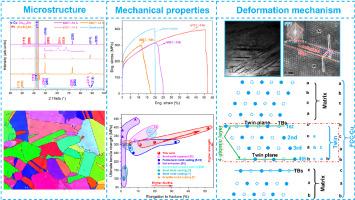Unveiling ultra-high plasticity and the mechanism of microstructural evolution in semi-solid squeeze-cast leaded nickel-tin bronze through solution treatment
IF 5.5
2区 材料科学
Q1 MATERIALS SCIENCE, CHARACTERIZATION & TESTING
引用次数: 0
Abstract
The effect of solution temperature (650 °C, 670 °C, 690 °C) on the microstructure and mechanical properties of semi-solid cast leaded nickel‑tin bronze (Cu-Sn-Ni-Pb) was studied. The results show that Sn-rich intergranular phases were essentially eliminated and accompanied by the formation of abundant annealing twins (ATs). The solution-treated (ST) promoted uniform diffusion of Ni and Sn elements into the α-Cu matrix, enhancing microstructural uniformity and suppressing Sn segregation. Both ultimate tensile strength (UTS) and elongation (E) initially increased and then decreased with rising solution temperature. When the solution temperature is 670 °C, the alloy exhibits the optimal combination of mechanical properties, with UTS and E reaching 394.5 MPa and 51.8 % respectively. Notably, compared to the as-cast alloy, E increased by 153.9 % with only a 1.7 % reduction in UTS, challenging the conventional view of this alloy's limited heat treatment response. This is mainly attributed to multiple microstructural defects generated during the tensile deformation process, including high-density dislocations, stacking faults (SFs), and deformation nano-twins (DNTs). This study provides a reference for the preparation of leaded nickel‑tin bronze alloys with high strength and ultra-high plasticity.

通过固溶处理揭示了半固态挤压铸造含铅镍锡青铜的超高塑性及其组织演化机制
研究了650℃、670℃、690℃溶液温度对半固态铸铅镍锡青铜(Cu-Sn-Ni-Pb)组织和力学性能的影响。结果表明,富sn的晶间相基本消除,并伴有大量退火孪晶的形成。固溶处理(ST)促进了Ni和Sn元素在α-Cu基体中的均匀扩散,增强了显微组织的均匀性,抑制了Sn的偏析。随着溶液温度的升高,极限抗拉强度(UTS)和伸长率(E)先升高后降低。当固溶温度为670℃时,合金的力学性能组合最佳,UTS和E分别达到394.5 MPa和51.8%。值得注意的是,与铸态合金相比,E增加了153.9%,而UTS仅降低了1.7%,挑战了该合金热处理响应有限的传统观点。这主要是由于拉伸变形过程中产生的多种微观结构缺陷,包括高密度位错、层错(SFs)和变形纳米孪晶(DNTs)。本研究为制备高强度、超高塑性含铅镍锡青铜合金提供了参考。
本文章由计算机程序翻译,如有差异,请以英文原文为准。
求助全文
约1分钟内获得全文
求助全文
来源期刊

Materials Characterization
工程技术-材料科学:表征与测试
CiteScore
7.60
自引率
8.50%
发文量
746
审稿时长
36 days
期刊介绍:
Materials Characterization features original articles and state-of-the-art reviews on theoretical and practical aspects of the structure and behaviour of materials.
The Journal focuses on all characterization techniques, including all forms of microscopy (light, electron, acoustic, etc.,) and analysis (especially microanalysis and surface analytical techniques). Developments in both this wide range of techniques and their application to the quantification of the microstructure of materials are essential facets of the Journal.
The Journal provides the Materials Scientist/Engineer with up-to-date information on many types of materials with an underlying theme of explaining the behavior of materials using novel approaches. Materials covered by the journal include:
Metals & Alloys
Ceramics
Nanomaterials
Biomedical materials
Optical materials
Composites
Natural Materials.
 求助内容:
求助内容: 应助结果提醒方式:
应助结果提醒方式:


